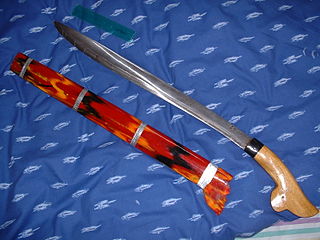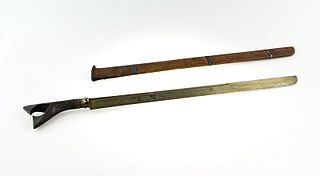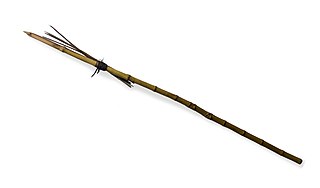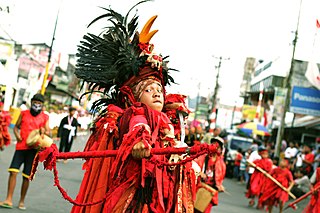
The karambit or kerambit, kurambik or karambiak is a small Indonesian curved knife resembling a claw from the Minangkabau people of West Sumatra. The karambit is one of the weapons commonly used in pencak silat and Indonesian martial arts.

The kris, or keris in the Indonesian languages, is an Indonesian asymmetrical dagger, both weapon and spiritual object, with distinctive blade-patterning achieved through alternating laminations of iron and nickelous iron (pamor). Of Javanese origin, the kris is famous for its distinctive wavy blade, although many have straight blades as well, and is one of the weapons commonly used in the pencak silat martial art, native to Indonesia.

A golok is a cutting tool, similar to a machete, that comes in many variations and is found throughout the Malay archipelago. It is used as an agricultural tool as well as a weapon. The word golok is used in Indonesia and Malaysia and in the Philippines. Both in Malaysia and in Indonesia, the term is usually interchangeable with the longer and broader parang. In the Sundanese region of West Java it is known as bedog.

The parang is a type of knife used across the Malay archipelago. It is often mistakenly assumed to be a sword; however, there is no evidence that it has ever been used in a formal military conflict, nor that its intended purpose was to be used as a combat weapon. Although some may argue that it could be called a machete or a chopper as it is a direct variation of the modern machete, its academic status remains as a knife.

Pencak silat is an umbrella term for a class of related Indonesian martial arts. In neighbouring countries, the term usually refers to professional competitive silat. It is a full-body fighting form incorporating strikes, grappling, and throwing in addition to weaponry. Every part of the body is used and subject to attack. Pencak silat was practiced not only for physical defense but also for psychological ends. There are hundreds of different pencak silat styles and schools which tend to focus either on strikes, joint manipulation, weaponry, or some combination thereof.

The rencong is a type of knife originating in Aceh, Indonesia. Originally a fighting weapon, it is most often seen today in the martial art of pencak silat and worn during traditional ceremonies.

The klewang or kelewang is a category of traditional single-edged sword that can be found throughout the Malay archipelago region in Indonesia and Malaysia. Usually it is shorter than a sword but longer than a machete. There are straight bladed types, but most are curved.

The kujang is a bladed weapon native to the Sundanese people of West Java, Indonesia. The earliest kujang made is from around the 8th or 9th century. It is forged out of iron, steel, and pattern welding steel with a length of approximately 20–25 cm and weighs about 300 grams. According to Sanghyang siksakanda ng karesian canto XVII, the kujang was the weapon of farmers and has its roots in agricultural use. It is thought to have originated from its predecessor, a kudi. The kujang is one of the traditional weapons in the Sundanese school of pencak silat. The kujang, like the keris, is a blade of sentimental and spiritual value to the people of Indonesia, who have a vast belief in supernatural powers.

Listed here are the weapons of pencak silat. The most common are the machete, staff, kris, sickle, spear, and kerambit. Because Southeast Asian society was traditionally based around agriculture, many of these weapons were originally farming tools.

Niabor is a curved sword from Borneo, a characteristic weapon of the Sea-Dayaks.

The Pandat is the war sword of the Dayak people of northwest Borneo and is never used as a tool. On October 18, 2016, this weapon was featured in season 3 episode 9 of the American bladesmithing competition series Forged in Fire.

Parang Nabur is a sword that originates from Banjarmasin, South Kalimantan, Indonesia. Most of these swords were made during the Banjarmasin Sultanate period in the 19th century.

Sikin Panjang is a sword originated from northern Sumatra, Indonesia.

Wedung is a traditional large knife of the Javanese people and the Balinese people originating from Indonesia.

A bambu runcing or prìng lancìp is a traditional spear made of a sharpened bamboo.

A Piso Halasan is a traditional sword of the Batak people from North Tapanuli Regency, North Sumatra, Indonesia.

Alamang or Sonri is a sacred sword or cutlass of the Bugis and Makassarese people in Sulawesi, Indonesia.

Kabasaran is a traditional Minahasan martial art and war dance from North Sulawesi in Indonesia. It is performed by several men clad in red costumes, wielding a sword with a shield or a spear. The dancers are called kawasalan, which implies imitating like a pair of fighter cocks. the word kabasaran is derived from kawasalan.

A kudi or kudhi is a bladed tool from Banyumas, Indonesia.






















